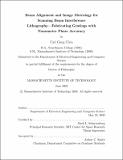Beam alignment and image metrology for scanning beam interference lithography : fabricating gratings with nanometer phase accuracy
Author(s)
Chen, Carl Gang, 1972-
DownloadFull printable version (8.609Mb)
Other Contributors
Massachusetts Institute of Technology. Dept. of Electrical Engineering and Computer Science.
Advisor
Mark L. Schattenburg.
Terms of use
Metadata
Show full item recordAbstract
We are developing a scanning beam interference lithography (SBIL) system. SBIL is capable of producing large-area linear diffraction gratings that are phase-accurate to the nanometer level. Such gratings may enable new paradigms in fields such as semiconductor pattern placement metrology and grating-based displacement measuring interferometry. With our prototype tool nicknamed "Nanoruler", I have successfully patterned, for the first time, a 400 nm period grating over a 300 mm-diam. wafer, the largest that the tool can currently accommodate. By interfering two small diameter Gaussian laser beams to produce a low-distortion grating image, SBIL produces large gratings by step-and-scanning the photoresist-covered substrate underneath the image. To implement SBIL, two main questions need to be answered: First, how does one lock the interference image to a fast-moving substrate with nanometer accuracy? Secondly, how does one produce an interference image with minimum phase nonlinearities while setting and holding its period to the part-per-million (ppm) level? My thesis work solves the latter problem, which can be further categorized into two parts: period control and wavefront metrology. Period control concerns SBIL's ability to set, stabilize and measure the image grating period. Our goal is to achieve control at the ppm level in order to reduce any related phase nonlinearity in the exposed grating to subnanometers. A grating beamsplitter is used to stabilize the period. I demonstrate experimental results where the period stabilization is at the 1 ppm level. An automated beam alignment system is built. The system can overlap the beam centroids to around 10 [mu]m and equalize the mean beam angles to better than 2 [mu]rad (0.4 arcsec), which translates into a period adjustability of 4 ppm at 400 nm. (cont.) Image period is measured in-situ via an interferometric technique. The measurement repeatability is demonstrated at 2.8 ppm, three-sigma. Modeling shows that such small period measurement error does not accumulate as growing phase nonlinearities in the patterned resist grating; rather, the resist grating has an averaged period that equals the measured period. Any phase nonlinearity is periodic and subnanometer in magnitude. SBIL wavefront metrology refers to the process of mapping the phase of the grating image and adjusting the collimating optics so that minimum image phase nonlinearity can be achieved. The current SBIL wavefront metrology system employs phase shifting interferometry and determines the image nonlinearity through a moire technique. The system has an established measurement repeatability of 3.2 nm, three-sigma. I am able to minimize the nonlinearity to 12 nm across a 2 mm-diam. image. Modeling shows that despite an image phase nonlinearity at the dozen nanometer level, printed phase error in the resist can be reduced to subnanometers by overlapping scans appropriately. From the point of view of period control and wavefront metrology, I conclude that SBIL is capable of producing gratings with subnanometer phase nonlinearities.
Description
Thesis (Ph. D.)--Massachusetts Institute of Technology, Dept. of Electrical Engineering and Computer Science, 2003. Includes bibliographical references (p. 279-285). This electronic version was submitted by the student author. The certified thesis is available in the Institute Archives and Special Collections.
Date issued
2003Department
Massachusetts Institute of Technology. Department of Electrical Engineering and Computer SciencePublisher
Massachusetts Institute of Technology
Keywords
Electrical Engineering and Computer Science.